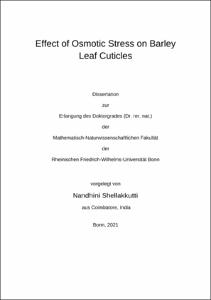Effect of osmotic stress on barley leaf cuticles

Effect of osmotic stress on barley leaf cuticles

| dc.contributor.advisor | Schreiber, Lukas | |
| dc.contributor.author | Shellakkutti, Nandhini | |
| dc.date.accessioned | 2021-07-19T07:20:04Z | |
| dc.date.available | 2021-07-19T07:20:04Z | |
| dc.date.issued | 19.07.2021 | |
| dc.identifier.uri | https://hdl.handle.net/20.500.11811/9223 | |
| dc.description.abstract | Assessing the drought stress tolerance at the seedling stage is an important trait as it later affects the growth and grain yield. The leaf and root characteristics are mainly focused on during this seedling stage. The outcome of osmotic stress induced by the application of PEG8000 on barley roots was examined previously by (Kreszies et al., 2019, 2020). In the present investigation, the study was extended to aerial parts focusing on the leaf response to osmotic stress under the same condition. Similar to suberin which prevents the uncontrolled water and ion movement in the roots, the aerial parts of the plants are covered by cuticles and they protect the shoot during the water deficit condition. The investigation was carried out on different physiological and chemical parameters of cuticles. Physiological adaptation by plants happens with less reduction in water content, immediate stomatal closure, decreased photosynthetic activity and accumulation of more compatible solutes. Subsequently, changes in wax/ cutin deposition and their gene expression pattern were studied. All the above-mentioned characteristics were measured on 12-d old cultivated barley (Hordeum vulgare spp. vulgare) and compared with wild barley (Hordeum vulgare spp. Spontaneum) as a response to osmotic stress induced by the application of PEG8000 (water potential -0.8MPa). Conclusions from these results will address if and how the cuticles help barley to cope with the water deficit conditions. | en |
| dc.language.iso | eng | |
| dc.rights | In Copyright | |
| dc.rights.uri | http://rightsstatements.org/vocab/InC/1.0/ | |
| dc.subject.ddc | 570 Biowissenschaften, Biologie | |
| dc.title | Effect of osmotic stress on barley leaf cuticles | |
| dc.type | Dissertation oder Habilitation | |
| dc.publisher.name | Universitäts- und Landesbibliothek Bonn | |
| dc.publisher.location | Bonn | |
| dc.rights.accessRights | openAccess | |
| dc.identifier.urn | https://nbn-resolving.org/urn:nbn:de:hbz:5-63153 | |
| ulbbn.pubtype | Erstveröffentlichung | |
| ulbbnediss.affiliation.name | Rheinische Friedrich-Wilhelms-Universität Bonn | |
| ulbbnediss.affiliation.location | Bonn | |
| ulbbnediss.thesis.level | Dissertation | |
| ulbbnediss.dissID | 6315 | |
| ulbbnediss.date.accepted | 09.07.2021 | |
| ulbbnediss.institute | Mathematisch-Naturwissenschaftliche Fakultät : Fachgruppe Biologie / Institut für Zelluläre und Molekulare Botanik (IZMB) | |
| ulbbnediss.fakultaet | Mathematisch-Naturwissenschaftliche Fakultät | |
| dc.contributor.coReferee | Hochholdinger, Frank | |
| ulbbnediss.contributor.gnd | 1244572012 |
Files in this item
This item appears in the following Collection(s)
-
E-Dissertationen (4400)




